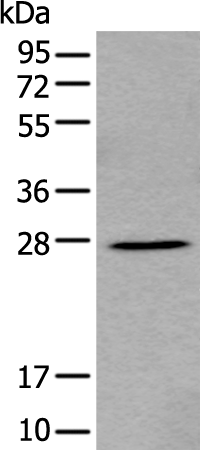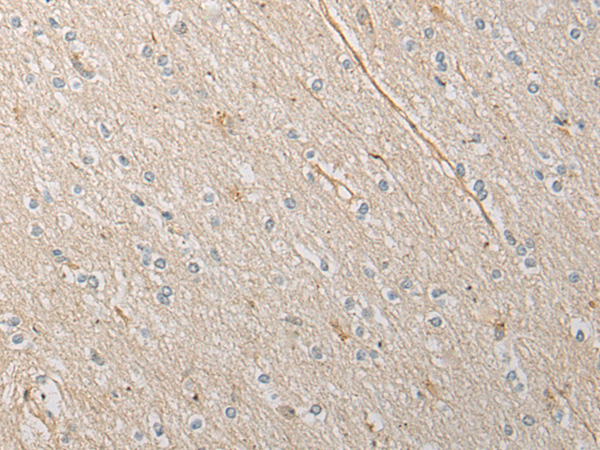


| WB | 咨询技术 | Human,Mouse,Rat |
| IF | 咨询技术 | Human,Mouse,Rat |
| IHC | 咨询技术 | Human,Mouse,Rat |
| ICC | 技术咨询 | Human,Mouse,Rat |
| FCM | 咨询技术 | Human,Mouse,Rat |
| Elisa | 1/2000-1/5000 | Human,Mouse,Rat |
| Aliases | INT2; HBGF-3 |
| WB Predicted band size | 27 kDa |
| Host/Isotype | Rabbit IgG |
| Antibody Type | Primary antibody |
| Storage | Store at 4°C short term. Aliquot and store at -20°C long term. Avoid freeze/thaw cycles. |
| Species Reactivity | Human, Rat |
| Immunogen | Synthetic peptide of human FGF3 |
| Formulation | Purified antibody in PBS with 0.05% sodium azide and 50% glycerol. |
+ +
以下是关于PIAS1抗体的3篇参考文献及其简要摘要:
1. **文献名称**:*PIAS1 regulates STAT1-mediated IFN-γ signaling through deSUMOylation*
**作者**:Liu B. et al.
**摘要**:该研究通过免疫沉淀和Western blot实验,利用PIAS1抗体验证了PIAS1蛋白在干扰素γ(IFN-γ)信号通路中的作用,发现PIAS1通过去SUMO化修饰调控STAT1的激活,影响免疫应答。
2. **文献名称**:*PIAS1 modulates breast cancer progression by stabilizing p53*
**作者**:Wang Y. et al.
**摘要**:研究使用PIAS1抗体进行免疫组化分析,发现PIAS1在乳腺癌组织中高表达,并通过与p53蛋白相互作用抑制肿瘤生长,提示其作为潜在治疗靶点的价值。
3. **文献名称**:*PIAS1 suppresses oxidative stress-induced apoptosis via regulating Nrf2 signaling*
**作者**:Zhang L. et al.
**摘要**:通过siRNA敲低和PIAS1抗体检测,研究揭示PIAS1通过调控Nrf2抗氧化通路减轻氧化应激诱导的细胞凋亡,为神经退行性疾病机制提供了新见解。
4. **文献名称**:*Tissue-specific roles of PIAS1 in inflammatory responses*
**作者**:Kumar A. et al.
**摘要**:利用基因敲除小鼠模型和PIAS1抗体进行Western blot分析,发现PIAS1在肠道和肺部炎症中通过抑制NF-κB通路发挥组织特异性抗炎作用。
The PIAS1 (Protein Inhibitor of Activated STAT1) antibody is a crucial tool in studying the PIAS1 protein, a member of the PIAS family that regulates diverse cellular processes. PIAS1 functions as a SUMO (Small Ubiquitin-like Modifier) E3 ligase, facilitating SUMOylation of target proteins, including transcription factors like STAT1. NF-κB, and p53. It modulates transcriptional activation, chromatin remodeling, and signal transduction pathways involved in inflammation, immunity, apoptosis, and stress responses. PIAS1 also interacts with nuclear receptors and plays roles in maintaining genomic stability. Dysregulation of PIAS1 is implicated in cancers, autoimmune diseases, and neurodegenerative disorders.
The PIAS1 antibody enables detection and analysis of PIAS1 expression, localization, and protein interactions in techniques such as Western blotting, immunoprecipitation, immunofluorescence, and chromatin immunoprecipitation (ChIP). Researchers use it to explore PIAS1's role in disease mechanisms, such as its tumor-suppressive or oncogenic effects in different cancers, or its modulation of inflammatory signaling (e.g., JAK-STAT, NF-κB). Commercially available PIAS1 antibodies are typically raised in rabbits or mice, with validation via knockout cell lines or siRNA knockdown to ensure specificity. Its application advances understanding of post-translational modifications, transcriptional regulation, and therapeutic targeting of PIAS1-associated pathways.
×